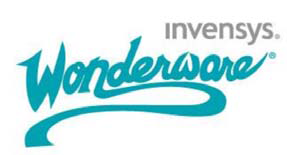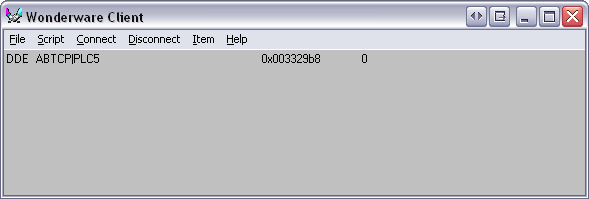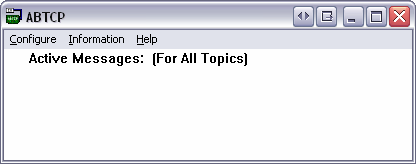
Application Note
Using Wonderware’s ABTCP driver with the EQ7000

PDF Download
Using Wonderware’s ABTCP Driver
Overview
Wonderware’s ABTCP IO Server is capable of reading and writing data to devices on the DH+ using the EQ7000. Before any data can be read or written, a new local host must be created in the host file and a topic must be defined in the ABTCP IO Server.
Configuring the Hosts File
The hosts file contains the names of local hosts and the IP addresses that are assigned to them. You must add a new entry to the hosts file with the IP address of the EQ7000. Below are the steps to adding a new entry to the hosts file.
1. Locate and open the hosts file. The host file can be found in the following directory.
C:\WINDOWS\system32\drivers\etc
2. Open the hosts file using a text editor like Notepad. You will see the following.

3. Add a line at the end of the file specifying a new host name and IP address and then save the file. In the example below, the host name EQ7000 is added and has an IP address of 192.168.2.75.

C:\WINDOWS\system32\drivers\etc
2. Open the hosts file using a text editor like Notepad. You will see the following.

3. Add a line at the end of the file specifying a new host name and IP address and then save the file. In the example below, the host name EQ7000 is added and has an IP address of 192.168.2.75.

Configuring a Topic in the ABTCP IO Server
Below are the steps to configuring a topic in the ABTCP IO Server.
1. Open the ABTCP IO Server. Select the Configure Option and then select Topic Definition.

2. In the Topic Definition window that just opened, click New to create a new topic.
3. Configure the topic as shown below. In the example below we created a topic with the name PLC5. The Host Name used is the one defined in the hosts file: EQ7000. Under the Connect Type, select remote via P.I. in order to let the IO server know that the message will be for a device connected to the DH+ side of the EQ7000. In the PLC Family, select the type of device that you will be communicating with. In the Network Addressing section, select the RM for the Module and 2 for the Chan. The DH+ Node value will be the node on the DH+ that you want to communicate with.

4. After the topic is configured, click OK to complete the setup. You will now have the new topic show up in the Topic Definition window.

5. Click Done to finish with configuring the topic definition.
Now that the topic is defined in the ABTCP IO Server, the next step is to use the Wonderware Client to connect to the EQ7000 and to poll data from the device specified in the topic.
1. Open the ABTCP IO Server. Select the Configure Option and then select Topic Definition.

2. In the Topic Definition window that just opened, click New to create a new topic.
3. Configure the topic as shown below. In the example below we created a topic with the name PLC5. The Host Name used is the one defined in the hosts file: EQ7000. Under the Connect Type, select remote via P.I. in order to let the IO server know that the message will be for a device connected to the DH+ side of the EQ7000. In the PLC Family, select the type of device that you will be communicating with. In the Network Addressing section, select the RM for the Module and 2 for the Chan. The DH+ Node value will be the node on the DH+ that you want to communicate with.

4. After the topic is configured, click OK to complete the setup. You will now have the new topic show up in the Topic Definition window.

5. Click Done to finish with configuring the topic definition.
Now that the topic is defined in the ABTCP IO Server, the next step is to use the Wonderware Client to connect to the EQ7000 and to poll data from the device specified in the topic.
Connecting Using the Wonderware Client
After a topic has been defined in the ABTCP IO Server, the next step is to connect to the EQ7000 in order to read and write data to the device on the DH+ network. Below are the steps to connect to the EQ7000 using the Wonderware Client.
1. Open the Wonderware Client and the ABTCP IO Server if it is not already open.

2. Click on Connect and the following window will appear. Setup the connection as shown. Use ABTCP for the Application and enter the topic name for the topic that was created in the previous section. For this example PLC5 is entered for the Topic since that was the topic created in the previous section. After this is configured, click the Connect button and then the Done button to close the window.
 3. If the ABTCP IO Server successfully connected to the EQ7000 you will see the following in the Wonderware Client and ABTCP IO Server.
3. If the ABTCP IO Server successfully connected to the EQ7000 you will see the following in the Wonderware Client and ABTCP IO Server.

 The Wonderware Client has now successfully connected to the EQ7000. The next step is to add items to read write to the device on the DH+ network.
The Wonderware Client has now successfully connected to the EQ7000. The next step is to add items to read write to the device on the DH+ network.
1. Open the Wonderware Client and the ABTCP IO Server if it is not already open.

2. Click on Connect and the following window will appear. Setup the connection as shown. Use ABTCP for the Application and enter the topic name for the topic that was created in the previous section. For this example PLC5 is entered for the Topic since that was the topic created in the previous section. After this is configured, click the Connect button and then the Done button to close the window.



Reading and Writing Data
After the Wonderware Client has connected to the EQ7000, the next step is to acquire data from the device on the DH+ network that a topic was created to. Below are the steps to add data items that can be used to read/write data.
1. Open the Wonderware Client and connect to the EQ7000.
2. To add an item to read/write, click on Item and the following window will appear.
 3. Add the datafile address that you wish to read. In the example above, the datafile N7:0 is going to be added.
3. Add the datafile address that you wish to read. In the example above, the datafile N7:0 is going to be added.
4. After the item is entered, click AdviseEx to add the item to the Wonderware Client.
5. Repeat step 4 to add more items. Click Done when finished adding items. Below is what the Wonderware Client will look like after an item is added. In the example below, the datafile N7:0 is being read.

1. Open the Wonderware Client and connect to the EQ7000.
2. To add an item to read/write, click on Item and the following window will appear.

4. After the item is entered, click AdviseEx to add the item to the Wonderware Client.
5. Repeat step 4 to add more items. Click Done when finished adding items. Below is what the Wonderware Client will look like after an item is added. In the example below, the datafile N7:0 is being read.
